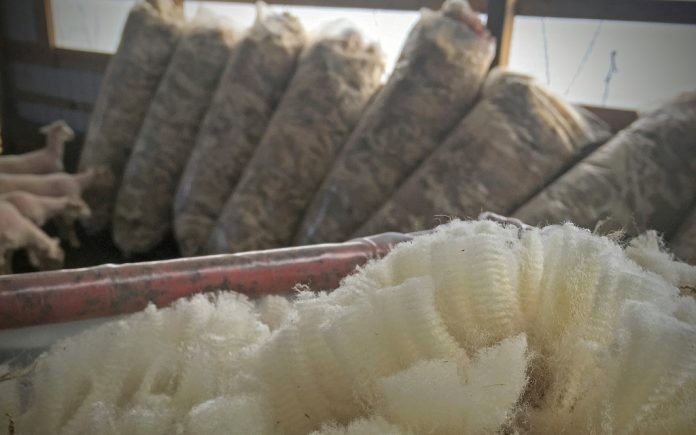
The chilled morning air in my house nipped my nose and numbed my fingers. The day before shearing day would not go as planned.
We had several shearers coming in, from Ohio, Pennsylvania and Maryland (by way of her latest shearing job in Michigan). The plan: knock out all 325-plus sheep in a day. We needed to get everything ready ahead of time — including some pre-sorting and arranging of which sheep needed to go where. But, first, we had to get the furnace going again. I couldn’t feel my hands.
Moving sheep
While we waited, we began to gather the flock for the move to the shearing barn’s pasture. They made the daily trek up to the upper fields to graze but had wandered back down by mid-morning. After thawing my hands, I hopped on the four wheeler, and brought them in, with the help of my border collie, Pili.
All right, next thing. Until my mother pulled in and said, “Did you know there’s a group of sheep you missed?” No, I didn’t. So, out we go again.
Moving more sheep
A little later, I headed up to the back fields with Pili. As I crested the hill, I saw a group of sheep spread out, placidly grazing. Completely unconcerned the flock had left them. Eye roll.
We started moving them down and, on a whim, I decided to go over the ridge line. Might as well, right? I saw one sheep standing in the shrubbery further back. Weird. I drove closer and saw a handful more. What was this? Did all of my sheep decide to do a hide-and-seek day without telling me? Pili and I started moving them down. My phone rang as we neared the barns. It was Mom. I answered without a greeting: “I know.”
Best laid plans
We began to try to get the two small groups to merge to get them over to the barn. I’ll spare you the details. They involve a lot of hair pulling, cussing and general irritation.
At one point, we’re all standing in ankle deep mud, staring at each other — humans, sheep and dog — unmoving. Pili gave me a confounded look at one point, when I questioned her about her herding decisions. “Look, I’m doing all I can. You try getting them to move out of this slop.”
We finally got them moving, in the right direction. I pulled my boots out the suctioning mud and sloshed along behind them. By then, it was late afternoon. We’d gotten the furnace fixed, but the other stuff, like sorting groups ahead of time? Nope. Not with sheep popping up like whack-a-mole all day.
We arranged the barn. Made sure the floor was as clear of straw and debris as possible, to avoid contaminating fleeces. And brought the flock in to wait for its haircuts.
Wool history
At one time in this country, large amounts of wealth were transferred on the backs of wool sheep. The founders owned flocks. Wool was the material of choice, especially during the Civil War. There are grainy black and white photos of a Shropshire flock grazing the White House lawn, to help save money on mowing, during World War I. Wool sales from those sheep raised money for the Red Cross.
In the 1940s, the United States was the world’s fifth largest wool producer. Wool was the primary product. Meat was second. Wartime propaganda touted the strength of U.S. influence, quantified by the valuation of wool.
Now, we’re removed from that time in history. We’re hearing less about how people didn’t like sheep meat because soldiers were fed poorly cooked mutton during wartime. If I had a dollar for every time I’ve heard that story.
Wool seems to be having a renaissance as well. Natural and renewable fibers are cool again. Nevertheless, many farmers and ranchers have moved away from wool sheep to hair breeds, because they don’t want the shear — especially because, other than fine wool, most prices have hit lows.
Texas, in particular, once filled with thousands upon thousands of fine wool sheep, has seen a huge shift to hair sheep in the past decade.
Good for us
Our wool genetics suit what we produce. Stroppy, hardy sheep that graze our strip-mined acreage well and produce a lot of good-doing lambs. The wool isn’t fancy. Wool prices being what they are for medium clip, it’s basically included as a cost of management for our farm. But there is still something about that annual ritual of taking off the wool.
I have sheared 40 sheep in my lifetime. It was a long time ago. I don’t plan to do any more. I know a number of shearers. As with many roles that make up the infrastructure in agriculture, shearing has become a lost art in many places. I respect those who still do it, especially those who do it well.
Another day done
The morning of shearing day, I got up early to prepare food for later. The shearers started rolling in at 7 a.m. The whir of the clippers started by 8:45 a.m. They clicked off the last time around 4:45 p.m. The whole flock was done, with time for lunch.
I’ve spent the days since slowly recovering from scampering back and forth, skirting fleeces for contaminated bits and climbing in and stuffing wool bags. Pro tip: it’s easier to stuff wool bags in stocking feet.
The sun was sinking in the west as we stood out in the barnyard chatting. My dogs were sprawled around us. My friend, the Maryland shearer, was about to get on the road for another job in State College, Pennsylvania. She, and the others, will be busy clicking along through the spring months, going from one shearing job to the next.
For us though, it was another shearing done, until next year.













